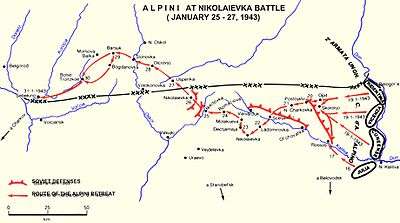Battle of Nikolayevka
The Battle of Nikolayevka was the breakout of Italian forces in January 1943, as a small part of the larger Battle of Stalingrad. The breakout involved a corps of the Italian 8th Army's near the village of Nikolayevka (now Livenka, Belgorod Oblast, in Russia).
| Battle of Nikolayevka | |||||||
|---|---|---|---|---|---|---|---|
| Part of the Battle of Stalingrad during the Eastern Front of World War II | |||||||
 Alpini route toward Nikolaievka, from the Don river | |||||||
| |||||||
| Belligerents | |||||||
|
|
| ||||||
| Commanders and leaders | |||||||
|
|
| ||||||
| Strength | |||||||
| 8–9,000 | 6,000 infantry (plus Soviet partisans) | ||||||
| Casualties and losses | |||||||
| Unknown | Unknown | ||||||
The breakout
The Italian 8th Army's Alpini (Mountain) Corps, consisting of the 3rd Julia, 2nd Tridentina and 4th Cuneense divisions and the 156th Vicenza Infantry Division to their rear, were at this point largely unaffected by the Soviet offensive on their right flank. On January 13, 1943, the Red Army launched the second stage of Operation Saturn. Four armies of General Filipp Golikov's Voronezh Front attacked, encircled, and destroyed the Hungarian Second Army near Svoboda on the Don to the northwest of the Italians and pushed back the remaining units of the German 24th Army Corps on the Alpini left flank, thus encircling the Italian Corps.
On the evening of January 17, the commanding officer of the corps General Gabriele Nasci ordered a full retreat. At this point only the Tridentina division was still capable of conducting effective combat operations. The 40,000-strong mass of stragglers—Alpini and Italians from other commands, plus German and Hungarian Hussars (Light Cavalry) —formed two columns that followed the Tridentina division which, supported by a handful of German armoured vehicles, led the way westwards to the Axis lines.
On the morning of January 26, the spearheads of the Tridentina reached the hamlet of Nikolayevka, occupied by a Soviet division, which repulsed Alpini's attack. General Luigi Reverberi, commander of the Tridentina division, led the final assault. As the 4,000 Alpini advanced, all remaining soldiers of the columns fell in and the Soviet formation, facing a human wave attack by many of the 40,000 Axis troops, abandoned the village. The Corps' Chief of Staff General Giulio Martinat was killed at the head of his troops on 26 January.
The retreat of the Alpini was no longer contested by Soviet forces and on February 1 the remnants of the Corps reached Axis lines. The Italians suffered heavy losses in the breakout: the Cuneense division had been destroyed; one tenth of the Division Julia survived (approximately 1,200 of 15,000 troops deployed) and one third of the Division Tridentina survived (approximately 4,250 of 15,000 troops deployed).
Aftermath
The battle has become an important point of reference for the Alpini and their fighting spirit. The Alpini Association also supports social programs in the city.
References
Bibliography
- Hamilton, H. Sacrifice on the Steppe. Casemate, 2011 (English)